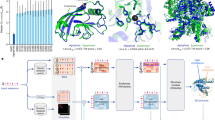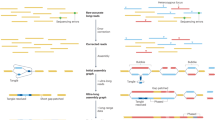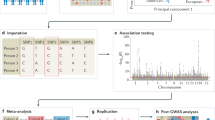Abstract
Genome-scale metabolic models have proven to be valuable for predicting organism phenotypes from genotypes. Yet efforts to develop new models are failing to keep pace with genome sequencing. To address this problem, we introduce the Model SEED, a web-based resource for high-throughput generation, optimization and analysis of genome-scale metabolic models. The Model SEED integrates existing methods and introduces techniques to automate nearly every step of this process, taking ∼48 h to reconstruct a metabolic model from an assembled genome sequence. We apply this resource to generate 130 genome-scale metabolic models representing a taxonomically diverse set of bacteria. Twenty-two of the models were validated against available gene essentiality and Biolog data, with the average model accuracy determined to be 66% before optimization and 87% after optimization.
This is a preview of subscription content, access via your institution
Access options
Subscribe to this journal
Receive 12 print issues and online access
$209.00 per year
only $17.42 per issue
Buy this article
- Purchase on Springer Link
- Instant access to full article PDF
Prices may be subject to local taxes which are calculated during checkout




Similar content being viewed by others
References
Yus, E. et al. Impact of genome reduction on bacterial metabolism and its regulation. Science 326, 1263–1268 (2009).
Kumar, V.S. & Maranas, C.D. GrowMatch: an automated method for reconciling in silico/in vivo growth predictions. PLoS Comput. Biol. 5, e1000308 (2009).
Feist, A.M. & Palsson, B.O. The growing scope of applications of genome-scale metabolic reconstructions using Escherichia coli. Nat. Biotechnol. 26, 659–667 (2008).
Thiele, I. & Palsson, B. A protocol for generating a high-quality genome-scale metabolic reconstruction. Nat. Protoc. 5, 93–121 (2010).
Overbeek, R., Disz, T. & Stevens, R. The SEED: A peer-to-peer environment for genome annotation. Commun. ACM 47, 46–51 (2004).
Aziz, R.K. et al. The RAST Server: rapid annotations using subsystems technology. BMC Genomics 9, 75 (2008).
DeJongh, M. et al. Toward the automated generation of genome-scale metabolic networks in the SEED. BMC Bioinformatics 8, 139 (2007).
Jankowski, M.D., Henry, C.S., Broadbelt, L.J. & Hatzimanikatis, V. Group contribution method for thermodynamic analysis of complex metabolic networks. Biophys. J. 95, 1487–1499 (2008).
Henry, C.S., Zinner, J., Cohoon, M. & Stevens, R. iBsu1103: a new genome scale metabolic model of B. subtilis based on SEED annotations. Genome Biol. 10, R69 (2009).
Suthers, P.F. et al. A genome-scale metabolic reconstruction of Mycoplasma genitalium, iPS189. PLOS Comput. Biol. 5, e1000285 (2009).
Notebaart, R.A., van Enckevort, F.H., Francke, C., Siezen, R.J. & Teusink, B. Accelerating the reconstruction of genome-scale metabolic networks. BMC Bioinformatics 7, 296 (2006).
Tsoka, S., Simon, D. & Ouzounis, C.A. Automated metabolic reconstruction for Methanococcus jannaschii. Archaea 1, 223–229 (2004).
Moriya, Y., Itoh, M., Okuda, S., Yoshizawa, A.C. & Kanehisa, M. KAAS: an automatic genome annotation and pathway reconstruction server. Nucleic Acids Res. 35, W182–W185 (2007).
Pramanik, J. & Keasling, J.D. Effect of Escherichia coli biomass composition on central metabolic fluxes predicted by a stoichiometric model. Biotechnol. Bioeng. 60, 230–238 (1998).
Satish Kumar, V., Dasika, M.S. & Maranas, C.D. Optimization based automated curation of metabolic reconstructions. BMC Bioinformatics 8, 212 (2007).
Kanehisa, M. & Goto, S. KEGG: Kyoto encyclopedia of genes and genomes. Nucleic Acids Res. 28, 27–30 (2000).
Kanehisa, M., Goto, S., Kawashima, S. & Nakaya, A. The KEGG databases at GenomeNet. Nucleic Acids Res. 30, 42–46 (2002).
Feist, A.M. et al. A genome-scale metabolic reconstruction for Escherichia coli K-12 MG1655 that accounts for 1260 ORFs and thermodynamic information. Mol. Syst. Biol. 3, 121 (2007).
Reed, J.L., Vo, T.D., Schilling, C.H. & Palsson, B.O. An expanded genome-scale model of Escherichia coli K-12 (iJR904 GSM/GPR). Genome Biol. 4, R54 (2003).
Durot, M. et al. Iterative reconstruction of a global metabolic model of Acinetobacter baylyi ADP1 using high-throughput growth phenotype and gene essentiality data. BMC Syst. Biol. 2, 85 (2008).
Oh, Y.K., Palsson, B.O., Park, S.M., Schilling, C.H. & Mahadevan, R. Genome-scale reconstruction of metabolic network in Bacillus subtilis based on high-throughput phenotyping and gene essentiality data. J. Biol. Chem. 282, 28791–28799 (2007).
Goelzer, A. et al. Reconstruction and analysis of the genetic and metabolic regulatory networks of the central metabolism of Bacillus subtilis. BMC Syst. Biol. 2, 20 (2008).
Schilling, C.H. et al. Genome-scale metabolic model of Helicobacter pylori 26695. J. Bacteriol. 184, 4582–4593 (2002).
Oliveira, A.P., Nielsen, J. & Forster, J. Modeling Lactococcus lactis using a genome-scale flux model. BMC Microbiol. 5, 39 (2005).
Feist, A.M., Scholten, J.C., Palsson, B.O., Brockman, F.J. & Ideker, T. Modeling methanogenesis with a genome-scale metabolic reconstruction of. Methanosarcina barkeri. Mol. Syst. Biol. 2, 2006 0004 (2006).
Jamshidi, N. & Palsson, B.O. Investigating the metabolic capabilities of Mycobacterium tuberculosis H37Rv using the in silico strain iNJ661 and proposing alternative drug targets. BMC Syst. Biol. 1, 26 (2007).
Nogales, J., Palsson, B.O. & Thiele, I. A genome-scale metabolic reconstruction of Pseudomonas putida KT2440: iJN746 as a cell factory. BMC Syst. Biol. 2, 79 (2008).
Duarte, N.C., Herrgard, M.J. & Palsson, B.O. Reconstruction and validation of Saccharomyces cerevisiae iND750, a fully compartmentalized genome-scale metabolic model. Genome Res. 14, 1298–1309 (2004).
Becker, S.A. & Palsson, B.O. Genome-scale reconstruction of the metabolic network in Staphylococcus aureus N315: an initial draft to the two-dimensional annotation. BMC Microbiol. 5, 8 (2005).
Douglas, A.E. Nutritional interactions in insect-microbial symbioses: aphids and their symbiotic bacteria Buchnera. Annu. Rev. Entomol. 43, 17–37 (1998).
Mahadevan, R. & Schilling, C.H. The effects of alternate optimal solutions in constraint-based genome-scale metabolic models. Metab. Eng. 5, 264–276 (2003).
Konstantinidis, K.T. & Tiedje, J.M. Trends between gene content and genome size in prokaryotic species with larger genomes. Proc. Natl. Acad. Sci. USA 101, 3160–3165 (2004).
von Eiff, C. et al. Phenotype microarray profiling of Staphylococcus aureus menD and hemB mutants with the small-colony-variant phenotype. J. Bacteriol. 188, 687–693 (2006).
Bochner, B.R. Global phenotypic characterization of bacteria. FEMS Microbiol. Rev. 33, 191–205 (2009).
Keymer, D.P., Miller, M.C., Schoolnik, G.K. & Boehm, A.B. Genomic and phenotypic diversity of coastal Vibrio cholerae strains is linked to environmental factors. Appl. Environ. Microbiol. 73, 3705–3714 (2007).
Gerdes, S. et al. Essential genes on metabolic maps. Curr. Opin. Biotechnol. 17, 448–456 (2006).
Zhang, R., Ou, H.Y. & Zhang, C.T. DEG: a database of essential genes. Nucleic Acids Res. 32, D271–D272 (2004).
Nakahigashi, K. et al. Systematic phenome analysis of Escherichia coli multiple-knockout mutants reveals hidden reactions in central carbon metabolism. Mol. Syst. Biol. 5, 306 (2009).
Karp, P.D., Riley, M., Paley, S.M. & Pellegrini-Toole, A. The MetaCyc Database. Nucleic Acids Res. 30, 59–61 (2002).
Acknowledgements
This work was supported by the US Department of Energy under contract DE-ACO2-06CH11357, by the National Institute of Allergy and Infectious Diseases under contract HHSN266200400042C and by the National Science Foundation under grants MCB-0745100, CCF-0829929 and DBI-0850546. M.D. was also supported by the Argonne National Laboratory Guest Faculty Program and the United States Fulbright Scholarship Program. We acknowledge the SEED annotators and development team for producing the annotations and computational infrastructure that make this work possible. We thank R. Overbeek, V. Vonstein, R. Olson, T. Disz, S. Devoid, F. Xia and T. Paczian for assistance with the use of the SEED genome annotation and analysis tools.
Author information
Authors and Affiliations
Contributions
C.S.H. developed and operated the Model SEED resource and the related algorithms with assistance from all other authors. All authors participated in curation and testing of the SEED models. M.D. contributed significantly to reaction network annotation, model testing and model curation. A.A.B. contributed significantly to template biomass reaction design, model curation and selection of organisms for reconstruction. P.M.F. contributed to reaction network annotation. R.L.S. contributed to model curation and the design of pipeline and algorithms. B.L. contributed to Model SEED web interface development. All authors contributed to the writing and revision of the manuscript.
Corresponding author
Ethics declarations
Competing interests
The authors declare no competing financial interests.
Supplementary information
Supplementary Text and Figures
Supplementary Methods and Supplementary Fig. 1 (PDF 676 kb)
Supplementary Tables
Supplementary Tables S1–S9 (XLS 4084 kb)
Rights and permissions
About this article
Cite this article
Henry, C., DeJongh, M., Best, A. et al. High-throughput generation, optimization and analysis of genome-scale metabolic models. Nat Biotechnol 28, 977–982 (2010). https://doi.org/10.1038/nbt.1672
Received:
Accepted:
Published:
Issue Date:
DOI: https://doi.org/10.1038/nbt.1672
This article is cited by
-
The sustainable approach of microbial bioremediation of arsenic: an updated overview
International Journal of Environmental Science and Technology (2024)
-
Genome insights into the plant growth-promoting bacterium Saccharibacillus brassicae ATSA2T
AMB Express (2023)
-
Amino acid auxotrophies in human gut bacteria are linked to higher microbiome diversity and long-term stability
The ISME Journal (2023)
-
Genome-scale metabolic reconstruction of 7,302 human microorganisms for personalized medicine
Nature Biotechnology (2023)
-
A genome-scale metabolic model of the effect of dissolved oxygen on 1,3-propanediol fermentation by Klebsiella pneumoniae
Bioprocess and Biosystems Engineering (2023)



